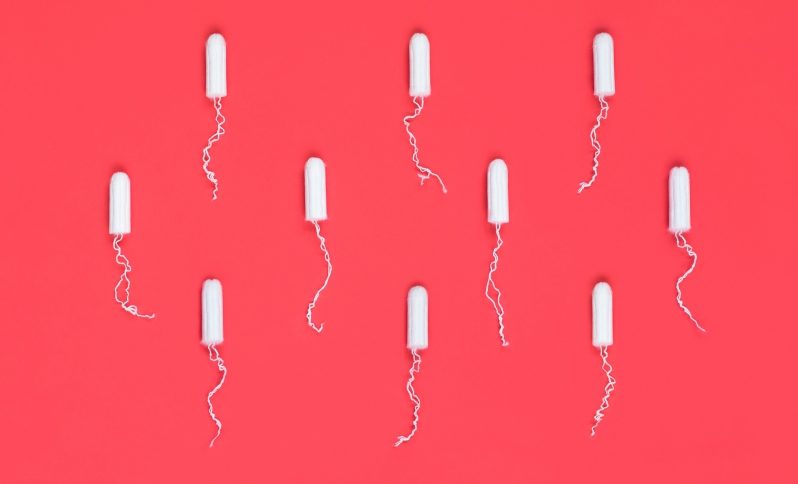
Advocates argue that FDA’s lax tampon regulations leave consumers exposed to significant risks.
Tampons remain a mystery to most consumers. The average tampon-user in the United States goes through about 11,000 tampons in a lifetime—yet the ingredients of these inserted products may never be known.
Although federal regulators claim that tampons sold in stores are safe, consumer health advocates argue that the lack of regulation surrounding this product could pose significant long-term health risks for consumers.
The U.S. Food and Drug Administration (FDA) currently regulates tampons as Class II medical devices, a classification that applies to devices with moderate to high risks. The agency requires tampon manufacturers to submit safety evaluations, which include a detailed description of the product’s composition and absorbency, risk assessments, and safety test results.
Yet the agency only recommends, rather than mandates, that tampon manufacturers inform consumers of the presence of chemicals in their products. Although some feminine hygiene companies voluntarily list basic ingredients on their product packaging, consumer health advocates urge all companies to provide more detailed information about the chemicals contained in tampons. In addition, these health advocates argue that FDA’s optional requirements for ingredient disclosure for Class II medical devices do not go far enough to encourage increased ingredient transparency from tampon manufacturers.
Depending on the chemicals they contain, tampons could pose a number of risks, argue health advocates. Regular, long-term use could lead to neurological and immunological effects, disruptions within the endocrine and reproductive system, and even cancer, but advocates also bemoan a lack of study into these possible effects.
In the past, FDA has acknowledged that rayon fibers used to maximize absorbency in tampons have been linked to an increased risk of toxic shock syndrome—a serious blood infection that occurs when a tampon has been inserted for too long. FDA does currently require tampon manufacturers to include special warning labels about the potential risks of toxic shock syndrome.
But some advocates also worry about the use of specific types of cotton in tampons in conjunction with rayon fibers. Around 94 percent of non-organic cotton in the United States is genetically modified and treated heavily with pesticides, and advocates worry that without long-term testing and disclosure, chemicals from cotton and rayon fibers in tampons could lead to health consequences.
Consumer health advocates have also voiced concerns about chemicals such as dioxin, which could potentially cause endometriosis. Although dioxin naturally occurs in the environment, and FDA testing shows that dioxin levels in tampons range from “non-detectable to one part in 3 trillion,” some experts caution against dismissing the risks of lifetime exposure. “When a woman uses several tampons throughout the day and somewhere in the neighborhood of 11,000 in her reproductive life, that’s a lot of dioxin exposures,” contends Philip Tierno, Jr., a clinical professor at the New York University Grossman School of Medicine.
According to FDA, because dioxin is only present at low levels in tampons, it does not pose a significant health risk. In an independent study that confirms this view, experts argued that because exposure to dioxin in tampons “is thousands of times less than the dioxin people typically consume in the food they eat,” consumers and legislators concerned about exposure should focus on reducing dioxin levels in their food, rather than in tampons.
Experts from the World Health Organization, however, have categorized dioxin as “highly toxic” and a “known human carcinogen.” In addition, advocacy groups such as Women’s Voices for Earth have conducted additional independent testing on tampons that detected reproductive toxins from rayon, carcinogens, and other volatile organic compounds. “These results underscore the need for more comprehensive testing to better understand the potential health risks that may arise from long-term product use,” argues Ami Zota, a professor at the George Washington University Milken School of Public Health.
Consumer concerns about tampon ingredient transparency have captured the attention of policymakers in recent years. For example, politicians such as U.S. Representative Grace Meng (D-N.Y.) and Representative Carolyn Maloney (D-N.Y.) have advocated greater ingredient transparency for tampons. Federal legislation, however, has yet to be enacted requiring such disclosures from manufacturers despite nearly a dozen attempts to pass a bill since the 1990s.
Without federal action, some states are taking the lead. In 2019, New York became the first state to require manufacturers to include ingredient labels for tampons on their packaging. California has since followed with a comprehensive tampon ingredient disclosure law of its own, which was enacted in September 2020.
Until more research is conducted on tampon ingredients, it may remain unclear whether tampons play a significant role in long-term health. Many who use tampons will continue to use tampons for decades without knowing what is in them, but further study combined with ingredient disclosures could empower consumers to make more informed decisions about their health and bodies.



